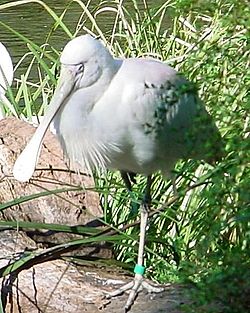Ciconiiformes: Difference between revisions
No edit summary |
|||
| Line 67: | Line 67: | ||
[[ar:لقلقيات]] |
[[ar:لقلقيات]] |
||
[[bg:Щъркелоподобни]] |
[[bg:Щъркелоподобни]] |
||
[[cs:Brodiví]] |
|||
[[da:Storkefugle]] |
[[da:Storkefugle]] |
||
[[de:Schreitvögel]] |
[[de:Schreitvögel]] |
||
Revision as of 17:56, 7 June 2007
| Ciconiiformes | |
|---|---|
| File:2002313 Saddlebilled Stork.jpg | |
| Scientific classification | |
| Kingdom: | |
| Phylum: | |
| Class: | |
| Order: | Ciconiiformes Bonaparte, 1854
|
| Families | |
Traditionally, the order Ciconiiformes has included a variety of large, long-legged wading birds with large bills: storks, herons, egrets, ibises, spoonbills, and several others. Ciconiiformes are known from the Late Eocene.
Taxonomic issues with Ciconiiformes
Following the development of research techniques in molecular biology in the late 20th century, in particular methods for studying DNA-DNA hybridisation, a great deal of new information has surfaced, much of it suggesting that many birds, although looking very different to one another, are in fact more closely related than was previously thought. Accordingly, the radical and influential Sibley-Ahlquist taxonomy greatly enlarged the Ciconiiformes, adding many more families, including most of those usually regarded as belonging to the Sphenisciformes (penguins), Gaviiformes (divers), Podicipediformes (grebes), Procellariiformes (tubenosed seabirds), Charadriiformes, (waders, gulls, terns and auks), Pelecaniformes (pelicans, cormorants, gannets and allies), and the Falconiformes (diurnal birds of prey). The flamingo family, Phoenicopteridae, is related, and is sometimes classed as part of the Ciconiiformes.
However, morphological evidence suggests that the traditional Ciconiiformes should be split between two lineages, rather than expanded, although some non-traditional Ciconiiformes may be included in these two lineages.
For example, the New World vultures (Cathartidae) are now usually included in the Ciconiiformes. This is not unequivocally accepted, but the vast majority of ornithologists believe it to be accurate based on morphological, behavioral and molecular evidence.
Some official bodies, notably the American Ornithologists' Union, have adopted the proposed Sibley-Ahlquist taxonomy almost entirely, however a more common approach worldwide has been to retain the traditional groupings, and modify rather than replace them in the light of new evidence as it comes to hand. The family listing here follows this more conservative practice. Bird taxonomy has been in a state of flux for some years, and it is reasonable to expect that the large differences between different classification schemes will continue to gradually resolve theselves as more evidence becomes available.
Cultural role
In most cultures, at least some members of the Ciconiiformes -- herons, storks, ibis, egrets and so on -- have always had an unusual status as objects of religious or artistic veneration. The attraction is certainly not phylogenetic. The morphologically similar, but unrelated, cranes are treated in the same way.
Sometimes hauntingly beautiful evocations of these birds are known from antiquity in, for example, Greece, Africa, Egypt, China, Vietnam and Japan. In Indo-European cultures the long-legged water bird tends to be a comical or even evil figure. The cultural phylogeny of these symbols would be an interesting study in itself, and their relative stability over millennia is surprising.
Behavior
Certainly one of the reasons for the attention given the ciconiiformes is their strange and alien way of moving. That special style of movement, whether perceived as graceful or comically awkward, is emphasized in the behavioral rituals common in the group. Some ciconiiforms are completely silent, and vocalization in most species is fairly limited. Thus, rituals and displays are the primary means of communication.
These behaviors seem to be almost completely genetically determined. In fact, one study analyzed the ritual behaviors of storks as if they were anatomical characters and reconstructed a taxonomic tree almost identical to the trees arrived at by anatomical or biochemical characteristics.
The rituals associated with initial mate selection, such as the male's "advertising" of his nest site and the female's expression of interest in the male's real estate, were quite extraordinarily stable.
Behaviours related to later events, such as copulation and pair-bond affirmation seem to be more phylogenetically plastic. Finally, behaviors not related to mating, such as the "anxiety stretch" or aggression displays, were quite variable, but still clearly inherited. This contrasts strongly with the song behaviors of passerine birds, which are strongly influenced by learning and individual experience.
Physical characteristics
Ciconiiformes have only a single pair of sternotracheal muscles in the syrinx; 16-20 cervical vertebrae; are diastataxic (the fifth secondary feather is absent, but fifth secondary covert is present); the feet are not webbed; the middle claw is laterally expanded, (pectinate in some families); intestinal ceca present, nearly always very small.
Ciconiiformes are extremely varied in size and shape. The smallest species are various bitterns of the genus Ixobrychus, some of which weigh less than 85 g (3 oz) and can measure as little as 30 cm (1 foot). Many of the largest of living flying birds are among the Ciconiiformes. Species that can approach or exceed a height of 1.5 m (5 feet) include the Goliath Heron, the Black-necked Stork, the Saddle-billed Stork, the Jabiru and the storks of the genus Leptoptilos. In terms of mass and wingspan, the largest of the Ciconiiformes is the Andean Condor, at up to 15 kg (33 lbs) and 3.2 m (10.5 feet) across the wings.
Ciconiiformes primarily occupy fresh water or terrestrial habitat, they are not filter feeders, and mostly feed on fish, crustaceans, insects, and carrion. They do not swim for food, and the northerly species migrate. They are strong flyers with broad wings.

Most nest in trees although some build nests in swamps or on the ground. The young are altricial. Most species are generally colonial but the use of sound is uncommon. Social communication is by displays and rituals.
References
- Slikas, B (1998), "Recognizing and testing homology of courtship displays in storks (Aves: Ciconiiformes: Ciconiidae)". Evolution 52: 884-893.
